MotoOnline.com.au takes Josh Waters’ Team Joe Rocket Suzuki Australian Superbike Championship winner for a blast at Phillip Island.
All action images courtesy of Steve Duggan – www.sdpics.com.
Waiting in line to enter the circuit at Phillip Island, the Team Joe Rocket Suzuki GSX-R1000 idles heavily as the temperature soars over the 100 degree mark.
There’s a lot of interest in this particular test and one that marks the highlight to finish off the year that was in 2009. Equipped with the number one plate earned by new Australian Superbike Champion Josh Waters, it’s my turn to ride in the boots of Waters for 15 laps of Superbike heaven.
The funny thing is, while I await the thrill ride that the Phil Tainton Racing-prepared Gixxer is sure to provide, the man who rightly owns that number one plate is about five riders behind me on his spare bike – standing tall with his rightly deserved numero uno.
Once directed onto the circuit for my first of two sessions on an epic Island day with the sun shining and wind blissfully low, my nerves are settled as my first impressions realise that the bike considered the most powerful in the ASBK is actually a very tame beast.
But while I’m tip-toeing my way around on the first lap, I know that J-Dub is somewhere within striking distance and would be sure to check that I’m looking after his lead bike before screaming past.
Sure enough he stalks me around the second half of the opening lap, flying past into Doohan Corner on lap two and quickly fading into the distance as he enjoys his debut with his new digit as he trades his customary number 21 in for number one for the 2010 season.
There’s something about testing factory race bikes that shines a whole new light on the occupation of being a motorcycle test rider. While the excitement in the lead-up to the event sky rockets, fear usually sets in the night before when the opportunity is about to become a very real reality.
Phil Tainton and team TJRS team including Waters and his mechanic Hayden Joyce have made me feel more than welcome upon arrival to this test though, but I can’t help but to reflect on the absolute weapon that was Shawn Giles’ bike when I tested it at the close of the 2006 season.
Yes, the 2009 model production GSX-R1000 is one that suits my style as it’s a lot more compact and user friendly than the K8 in the engine department, but we all know that Tainton is one of the best in the business at extracting ponies from GSX-R engines.
After Waters flew by me on track in session one I eased into a rhythm, getting a feel for the bike and also reuniting myself with the high-speed 4.445-kilometre Phillip Island Grand Prix Circuit.
The reach to the standard handlebars is short and the aftermarket fairings – complete with a hand-built stiff foam seat pad – and suspension settings prop you up slightly higher than the standard version.
Higher foot rests also position you in a manner that puts you over the front-end of the bike, although the seating feels relatively balanced considering the slight ergonomic changes over the production bike.
All of the controls feel very much identical to the GSX-Rs that you’ll find in dealers throughout the country, although the use of the switch gear buttons are completely different as you’ll see in the technical sidebars.
Once up and running a few laps into my first session it’s confirmed that the K9 GSX-R1000’s rideable traits have transferred directly over to the factory race bike.
Don’t get me wrong, it’s blazingly fast with 210 horsepower at the rear wheel, but Tainton says that the torque is actually lower than the previous model, making it easier to ride at speed as you strive to get that power to the ground.
While most modern factory Superbikes intimidate you to the point of parking them after the first lap, Waters’ weapon is a delight to ride, thrilling in its power output, while amazing in its ability to play nice.
In fact, you could hand this bike to almost every regular ride day punter in the country and they’d love it, taking full advantage of a powerband that has a broad torque curve throughout without being too aggressive in its nature.
Once the first session came to an end, a quick chat with Waters in between stints gave me more of an idea of what gears he takes each turn in, which was difficult to work out due to that massive power range fed from the engine via the throttle to the rear tyre.
Take Southern Loop for example, I could easily roll through there in either second, third or fourth gear and the engine would hardly lag on the exit. It wouldn’t always be in the optimum rev range of course, but it pulls like the team’s Mack transporter either way.
If it wasn’t for the massive gear indicator situated in the centre of the digital Motec dash then it would be tough to tell if the bike’s in third or fourth gear at many times as the two have very similar characters unless you’re pushing at race pace.
Coming onto Gardner Straight it’ll wheelie in fourth gear as you crest the hill, accelerate as you shift up to fifth and fly toward 300 kays an hour as you hit top gear just past the start and finish line.
The power comes on strong from as low as 6000rpm, building steadily at 8000rpm and then quickly reaching its maximum power point of 13,200rpm – 1000rpm below the actual limit.
Of note, my preferred engine mode setting is the B mode, just like the champ, except for the fact that he rides it to the limit with great effect.
In the second session I begin to get a better feel for the chassis, and there’s no doubt that Tainton and the team have managed to retain the awesome front-end feel that the production version boasts.
The front brakes feel strong and consistent into the tighter turns thanks to the Brembo master-cylinder, Goodrich lines, and Yoshimura pads, while the rear brakes are typical Gixxer as they’re totally standard.
The transition from hard braking to the corner entrance in sections like Turn Four and MG is exceptional, while I never was able to pick up the gas as early as the bike would allow simply because it’s hard to get your head around the grip that the suspension and Dunlop N-Tec tyres provide.
Compared to your standard street tyres, the N-Tecs have a lot more flex when you’re putting the power to the ground, feeling as though they’re peeling off the tar beneath them as you accelerate off of the second and third gear turns.
The front also feels as though its carving into the ground, and Waters says that he likes his bike to feel as though its connected to the tar with glue – hence the soft suspension settings.

Change of direction is a cinch, while the ergonomics are typical GSX-R despite the race fairings and seat.
Faster corners prove somewhat trickier to tackle due to the outright speed of the Island on a Superbike, although the soft setting that Waters runs his bike at provides maximum feel in the connection to the tarmac.
It holds its line right on target wherever you steer it, but a little bit more aggression from my side would add some extra weight over the front tyre on the sweeping turns.
Tainton says that the team could get the bike to steer even better with a stiffer rear setting, although it’s a compromise because of rear tyre wear. Rival teams beware, more development is on its way.
The quicker corners such as Doohan Corner and The Hayshed come at you quicker than Danny Green in a world title bout, with the stability of the GSX-R continuously surprising me compared to previous Superbikes I’d tested.
Waters compares it to a 600 Supersport bike in the way it reacts, something I’d had trouble comprehending previously, but in my 15 laps of fame I certainly agree with his claims.
It does everything spot on, so precisely, yet in an extremely quick manner, certainly making the 2009 Team Joe Rocket Suzuki GSX-R1000 the most impressive Superbike I’ve ever swung a leg over.
TECHNICAL FEATURES:
ENGINE DEVELOPMENT
Team Joe Rocket Suzuki manager Phil Tainton is a guru when it comes to fettling with motorcycle engines, producing many champions within the factory Suzuki team and also via Phil Tainton Racing’s customer base.
The engine of the TJRS GSX-R1000 produces a whopping 210 horsepower at the rear wheel and stomps out 91ft-lbs of torque, featuring a host of internal modifications while revving to a limit of 14,200rpm.
Maximum power is produced at 13,200 before rolling off, while the max torque is output at 10,700rpm.
Yoshimura parts are littered throughout the engine including ST-R Type R camshafts that feature a higher lift and produce power gains throughout, while there are also Yoshimura valve cotters (collets) and a smaller (aka lighter) alternator fitted.
Phil Tainton Racing has ported and flowed the cylinder-head after many hours on the flow bench, machining the head down and removing material from the piston valve pockets to accommodate the extra cam lift.
Below the head it is surprisingly standard between the cases, with the con-rods, crank-shaft, gearbox, valves, valve springs and valve retainers all remaining as standard equipment.
In saying that, there’s a Yoshimura kit clutch fitted featuring springs and plates more suitable for racing environments.
A Yoshimura USA R77 full system race exhaust has been fitted, also producing large power gains.
Adding to the power are trick prototype air intake funnels made in-house by PTR, set to be readily available once the team gets the time to produce them in large quantities.
TJRS uses BMC air filters.
Gearing for Phillip Island has been changed to a 16-tooth front sprocket and a 43 rear, while the tighter circuits around the country see the team fit a 44-tooth sprocket on the rear.
Motul is the team’s oil supplier.
The ECU fitted to the TJRS GSX-R is the Yoshimura EM Pro, which has fully-adjustable settings for fuelling, ignition, rpm limit, and a ‘spin control’ that’s operated when the ECU recognises a spike in the engine RPM, retarding the engine and reducing the wheel spin.
Suzuki’s standard GSX-R has the three-level engine power settings and the EM Pro runs directly through those A, B and C modes, although instead of reducing power, the three modes simply revise the amount that the spin control kicks in.
There are also two ECU maps that are changeable via the hazard light switch, one being a dry setting with full power and the other being a rain setting, retarding the throttle at two, five and seven percent opening on both levels, but more so on the wet setting.
All of these maps and configurations are developed by PTR after speaking to the riders and then researching the data, adjusting the settings as required for each particular circuit and weather condition.
CHASSIS REFINEMENT
Chassis revisions and restrictive in Australian Superbike racing compared to what’s allowed in the world championship, with TJRS making the most of limited adjustments allowed on the GSX-R1000.
It’s fitted with Öhlins suspension components at the front and rear, featuring standard Showa fork externals with FGK 25 millimetre cartridge kits set-up to suit the TJRS riders. The rear shock absorber is the TTX 36, also set to answer to the riders’ needs after much testing and development.
Perhaps the most expensive feature of the chassis is the Motec data logging system, run from the GPS dash and measuring the suspension movements, throttle position, engine RPM, water temperature, oil temperature and pressure, front and rear wheel speeds, brake status, airbox pressure, tyre temperature, plus engine exhaust and gas mixtures.
There’s also a sensor to automatically increase the RPM upon downshifting in second to sixth gears, assisting the bike to settle upon the corner entrance without requiring the rider to blip the throttle manually.
The GPS was implemented last year, giving the team added knowledge on the lines that the riders are taking and enabling them to compare lines from a satellite view should one rider be struggling in a particular corner more than his teammate.
Tainton explains that the only downside of using the Motec dash is that it doesn’t display the engine A, B and C power settings, forcing the riders to remember what level they program into it via a flick-switch on the handlebar after it defaults to A upon start up.
Waters prefers the B setting that makes the spin control kick in more, while Shawn Giles and Robbie Bugden both ride in the A mode. Tainton usually flicks the button into the B mode for Waters before the race warm-up lap.
The front brakes are standard apart from a Brembo master-cylinder and lever, Goodrich braided brake lines and Yoshimura brake pads, while the rear brakes are completely standard.
PTR has developed adjustable rear-sets for the bikes, with the standard gear shifter also utilised.
Completing the chassis componentry is an Öhlins steering damper, Yoshimura engine covers, Ozynob frame protectors, RK Chains, AFAM sprockets, Racers Edge fairings, a Vortex fuel cap and a custom seat hump to help Waters in keeping his bodyweight forward on the bike.
The fairings are painted by Original Finish Motorcycle Spray Painting, while decals are made by Excel Signs.
Sharp stands are also used by the team when the bikes are stationary in the pits.
Interestingly, the team removed the Ozynobs to save weight for the championship finale, while a lightweight battery is utilised to save three kilograms at only 0.7 kilos in total.
THE CHAMP’S TAKE
The turning point in Josh Waters’ 2009 Australian Superbike Championship campaign was when the 2009 model Suzuki GSX-R1000 was delivered just in time for Eastern Creek’s fourth round.
From that point on Waters was incredibly strong, taking pole position at the Creek and then winning four of the eight championship races to round out the season.
“The K9 is a lot more similar to a 600 to ride,” Waters explained. “The K8 was obviously a competitive bike, but the way that the power came on was a lot more aggressive, so I feel a lot more comfortable on the new model.”
As for what the strong points of the K9 model, Waters recognises two key points that have helped him in moving forward.
“I think the bike is good everywhere, but its strong points are definitely its speed – it’s fast – and also the rolling speed that I can carry into the corners, they are the two main strong points.
“I can get on the gas a lot earlier and the lap times just seem to come a lot easier on this model compared to the previous one. It’s a lot easier because I can roll on the throttle earlier and be 100 percent confident in it.
“There’s no doubt that the bike’s really fast, but I think its character in allowing me to get on the gas earlier out of the corners makes it quicker down the straights, too.”
In comparing the previous incarnation with the championship winner, Waters has a unique theory in describing the pair.
“When I describe the difference between the K9 and K8 I always say it’s like a cat versus a tiger – the new bike being a friendly cat, but a very fast one I guess,” he laughed.
The development of the bike has been gradual in the hands of team manager Phil Tainton, with Waters getting a good feel for the bike in initial testing and then building upon the development from that point.
“Straight away I knew that it was a good bike, but once I had my second test on it at Winton and went really quick then I knew that it was going to be a good bike once we started racing it at Eastern Creek,” he reflected.
“Phil started with a base engine setting for Eastern Creek, Mallala and the Australian Superbike Open at Phillip Island, just working really hard on the chassis, but then Phil started working on developing the engine further after that for the final rounds at the Island.”
It’s been a dream campaign for the new Gixxer and TJRS, with the team set to continue development of the same bike heading into the 2010 season.


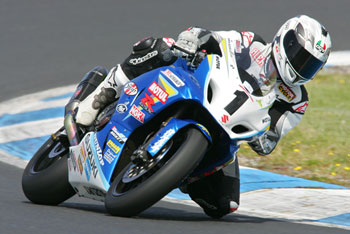
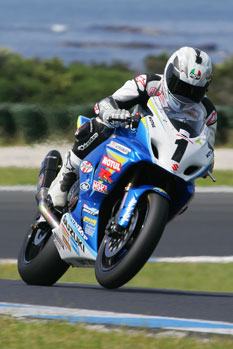
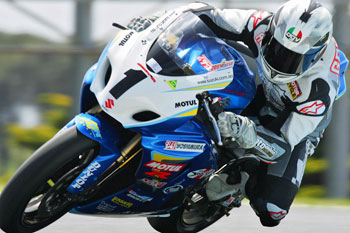
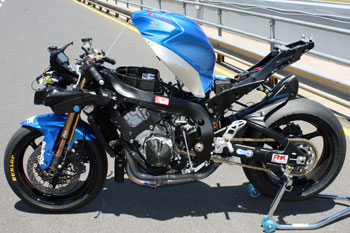
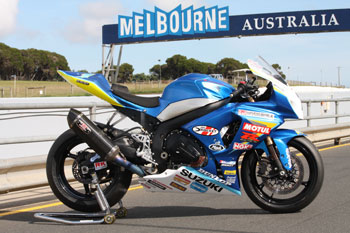
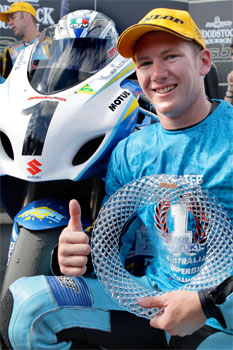





Newsletter